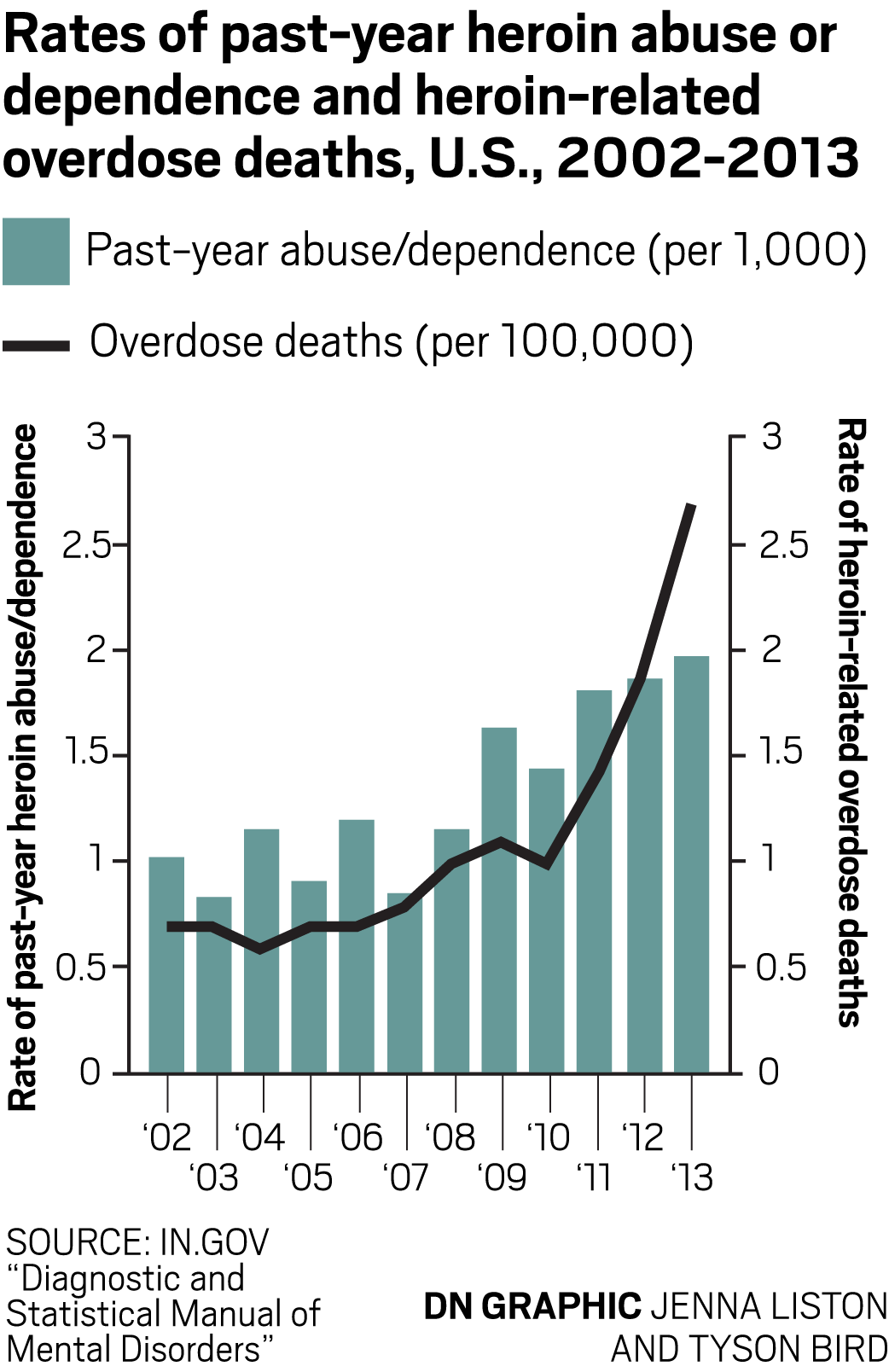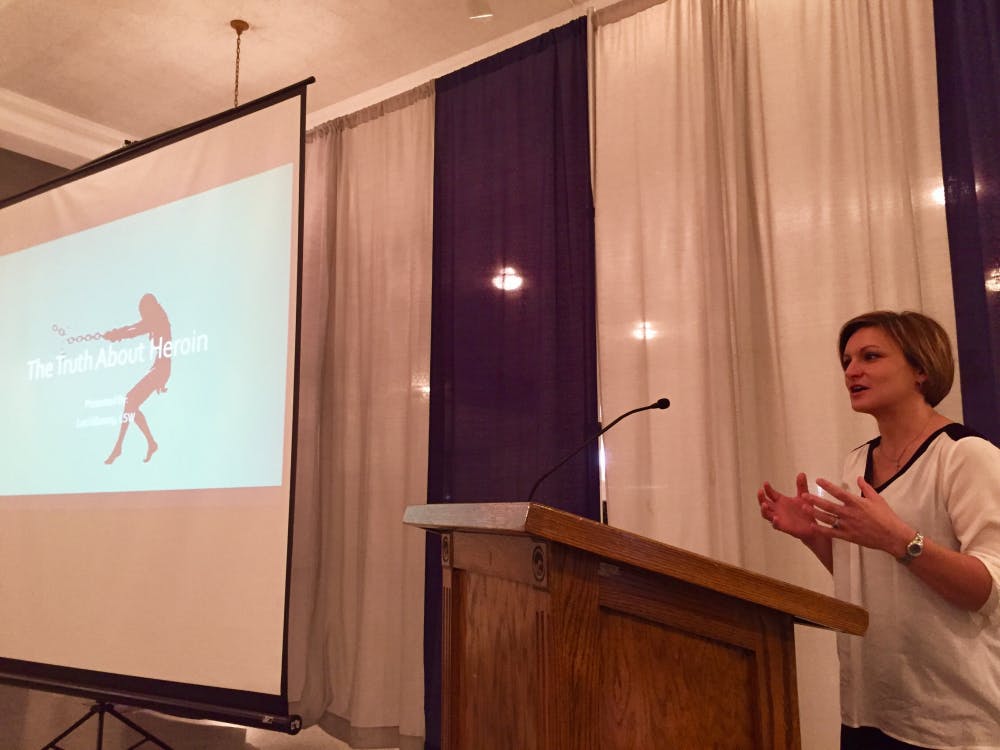Beaten to the ground after owing a drug dealer money, Laci Giboney listened to the dealer's plan to kill her and dispose of her body.
It was at that moment she knew God was on her side, and she needed to make a change.
After doing heroin for the first time at the age of 20, the drug changed Giboney’s life forever.
Giboney lost her baby when she was seven and a half months pregnant, and she used heroin to deal with her everyday life.
"I had lost my child, and I needed an escape," she said. "I didn’t know where it would take me, and at the time I didn’t really care as long as it let me escape reality. ... I just needed to feel normal again. Heroin made me feel normal."
Now a therapist with mental health provider agency Unified Solutions, Giboney spoke at an Indiana Youth Institute community forum in Muncie on March 29 to provide insight on heroin addiction and how current users can break the cycle.
Heroin use among students in Eastern Indiana counties peaks during the sophomore and then again senior year, according to a 2015 survey from the Indiana Prevention Resource Center. The rising issue of drug usage is what led Giboney to speak up about her experiences.
Her presentation aimed to educate the community and make people aware that this is a problem. In 2013, an estimated 22.7 million individuals ages 12 or older needed treatment for an illicit drug or alcohol use problem, and 2.5 million received treatment at a specialty facility, according to the National Survey on Drug Use and Health report.

Giboney blamed some of these high numbers on drugs like marijuana, which can help people escape their anxieties and eventually may become a gateway to more dangerous drugs.
“Teenagers become so accustom to the effects of marijuana that they need something more," she said. "The drugs people buy on the street have no quality assurance, so they really do not know what they are getting."
Lenny Popp, head of the Delaware County Drug Task Force for 16 years, said the county is focused on reducing heroin use, which can result in higher numbers of arrests.
“Yes, Delaware County has high numbers of heroin arrests," Popp said. "But people wonder why our numbers are so high — it is because we are the ones tackling the issue and not letting it slide by anymore."
Popp said heroin is a major problem in the county but is slowly being taken over by cocaine due to the shift in prices. Crack heroine sells for around $300 a gram while cocaine begins around $65 a gram, Popp said.
The drug task force has undercover officers who go on the scene of the drug deals to purchase the drugs as if they were for themselves. On average, Popp receives four to five drug deal calls a day. He said going on site can be stressful at times and does not always go as planned.
“You can plan as best you can," he said. "You work so hard to make it safe but when you involve addicts, drugs and money, you can never dictate how it will go."
Giboney wanted to make sure everyone in the audience knew that addiction is a brain disease. Once she became sober, she finally knew what withdrawal meant.
“It was really hard…For about two weeks you are in pain and are severely depressed," Giboney said. "At that time, people contemplate death and sometimes do not make it due to suicide. That is why I am here today, to help those people who need someone to care about them and keep going."
Family made a big impact on her life throughout her addiction, and she preached that family and friends are there to help.
“I had lost everything," Giboney said. "My family had stopped giving me money, I didn't have a bed to sleep in anymore, no more food prepared every night…I was alone. I think that was the harsh reality that everyone who is an addict should experience, regardless of how painful it is to realize."
Now she is starting her own center for women ages 18 and older dealing with a drug addiction. Transformation centers for healing will provide treatments like sauna detoxifications and wellness programs to help women get back on track with a healthy lifestyle.
Stephenie Grimes, an emergency preparedness employee and audience member, said the presentation shined a different light on the situation.
"Working in emergency preparedness, I appreciate the law enforcement component and working directly with addicts," Grimes said. "It was great to hear the other side of the story instead of just a punishment and not hearing their story.”
The new treatment program offers a six-month inpatient and three-month transitional service. The longer treatment will allow women to get back on their feet and become sober while the shorter treatment will help women balance their lives and make sure everything from their homes to their jobs are in line.
The treatment program is planned to be open by spring of next year and is looking for government funding to help regulate costs.
“I should have been dead numerous times of all of positions I put myself in, but I made it through, and others can, too,” Giboney said.




